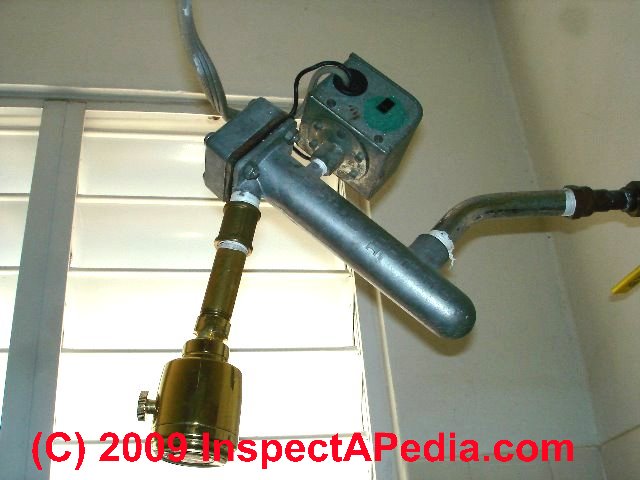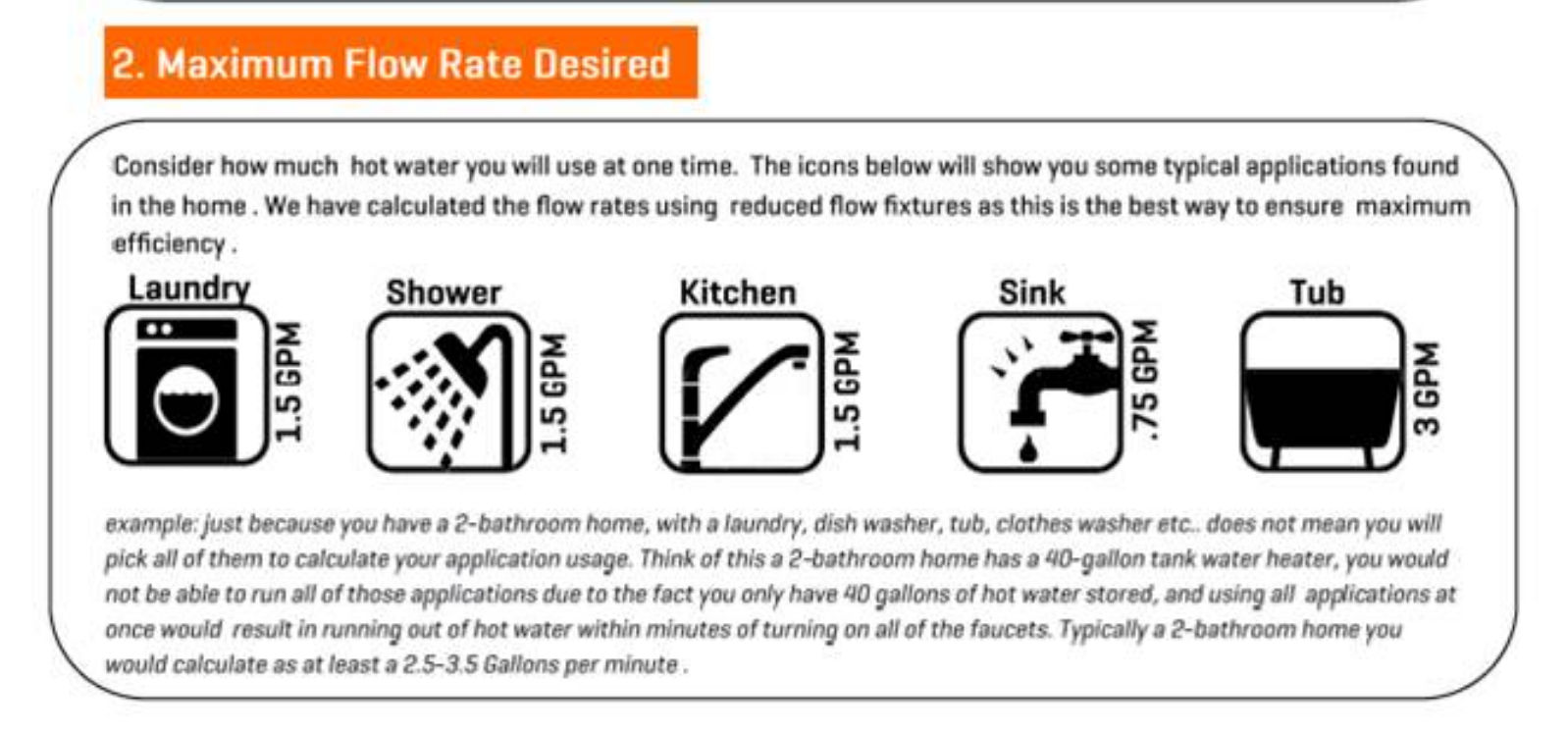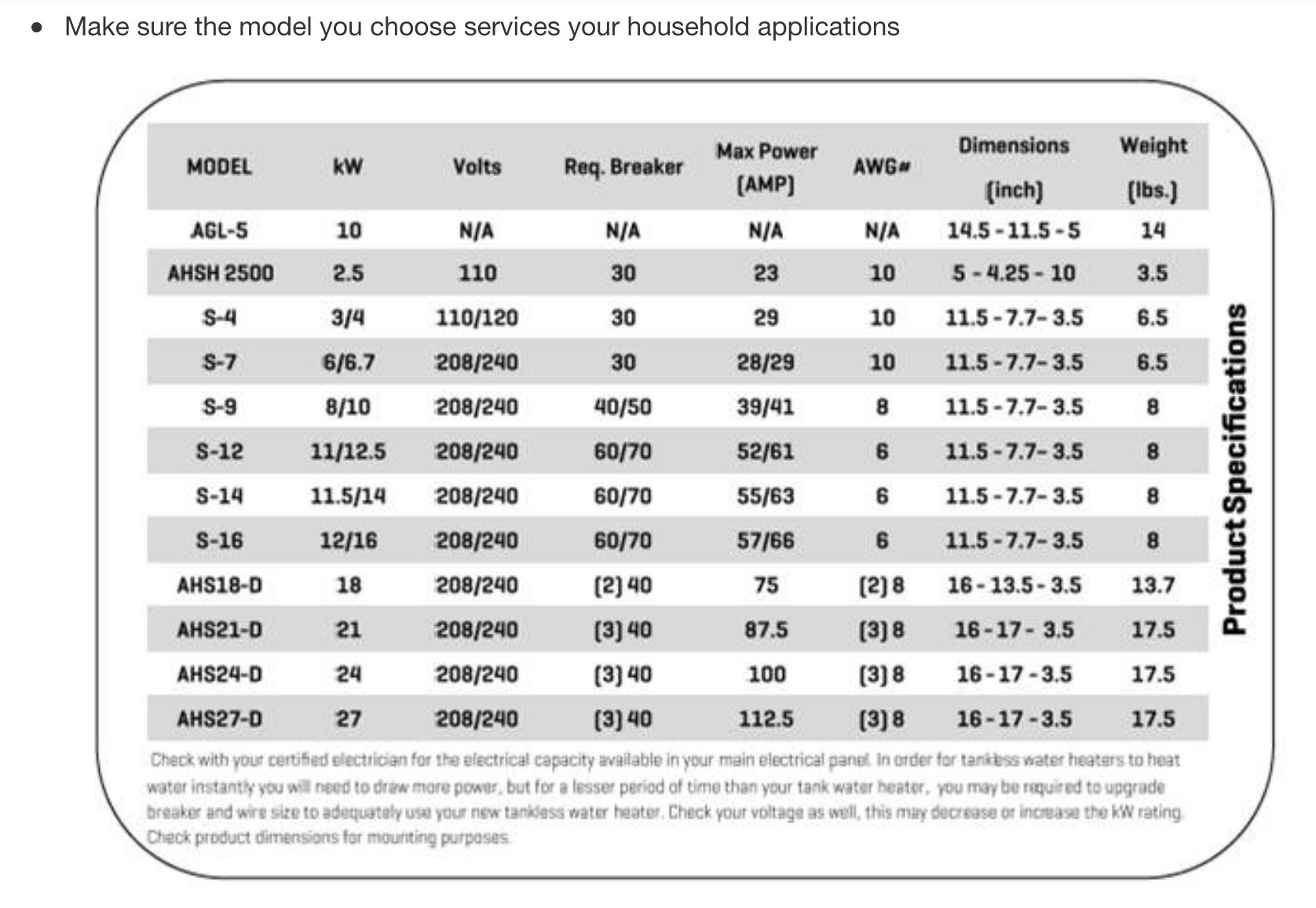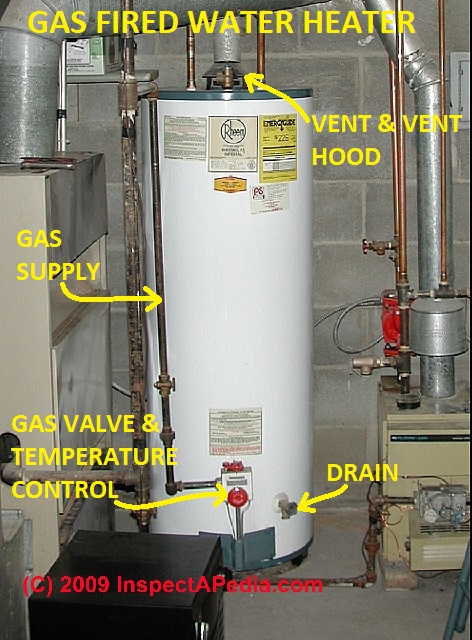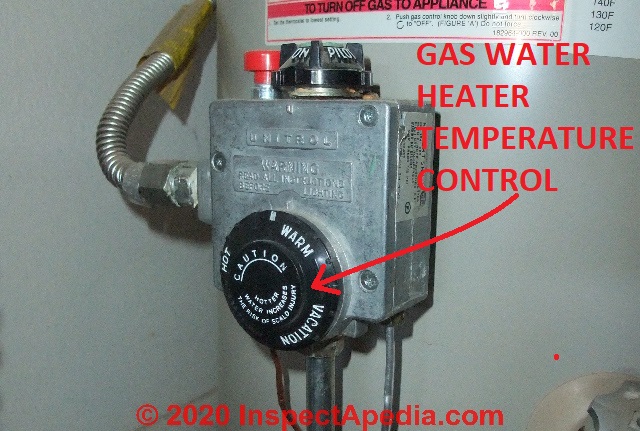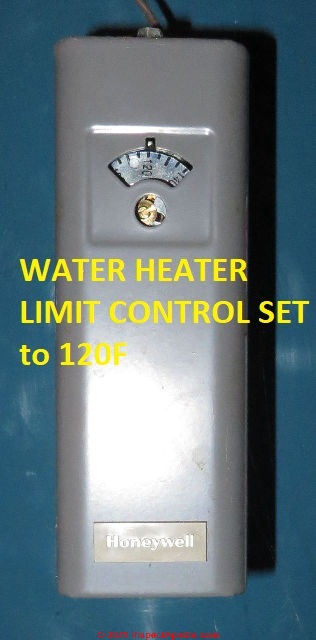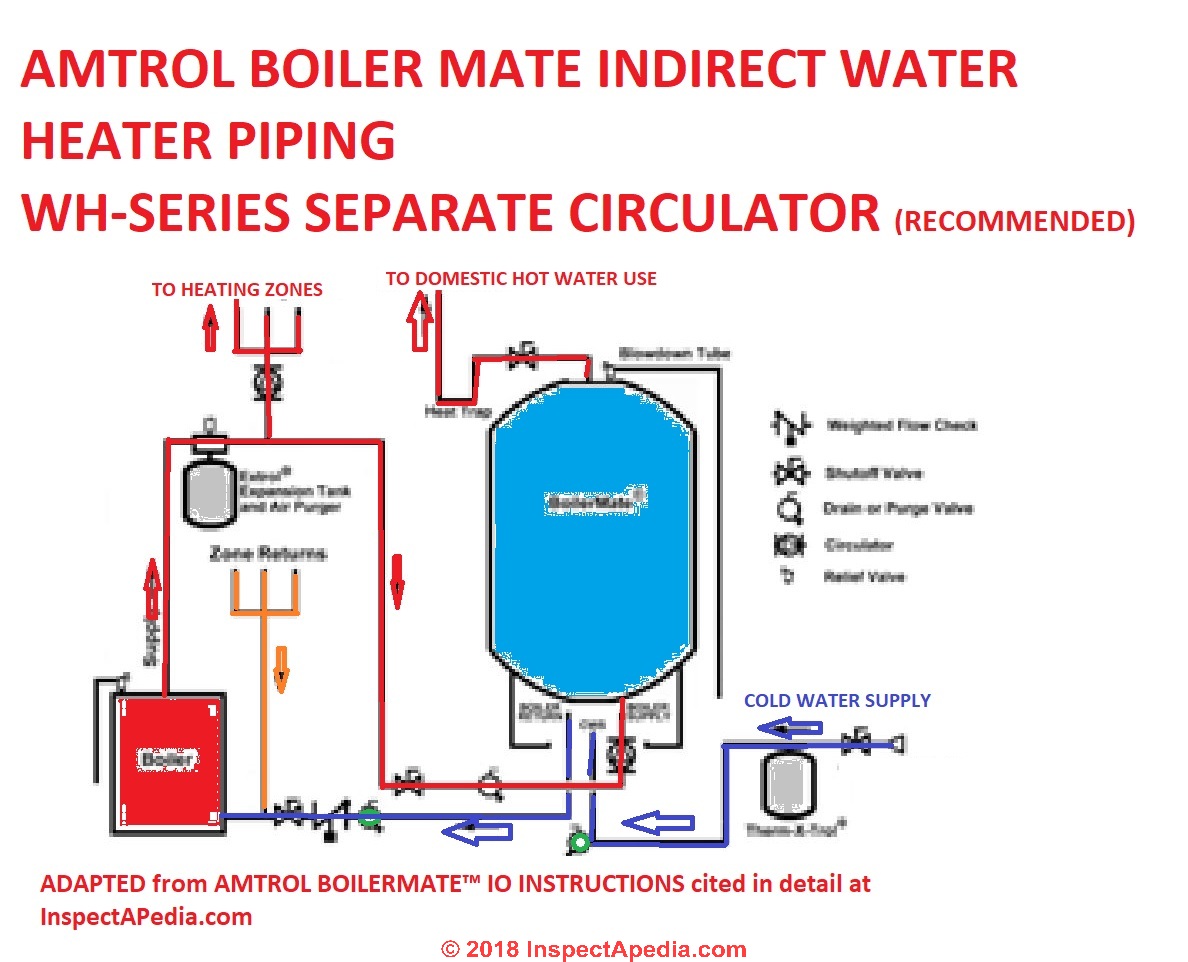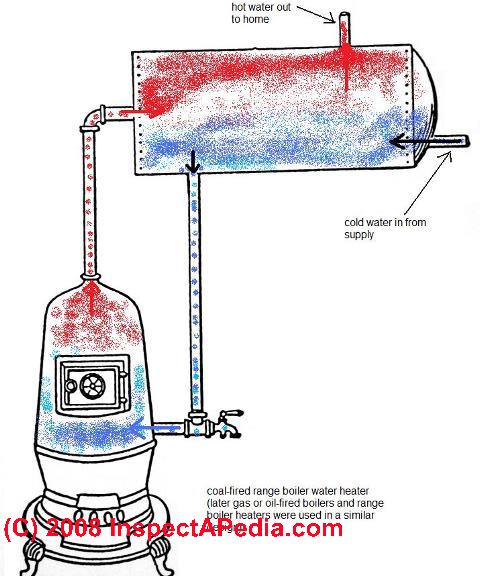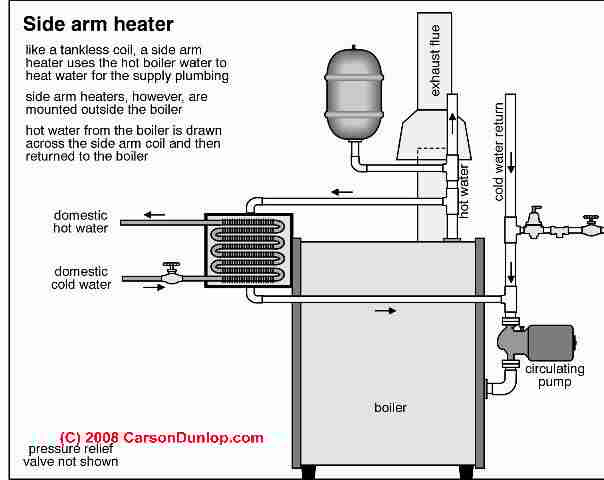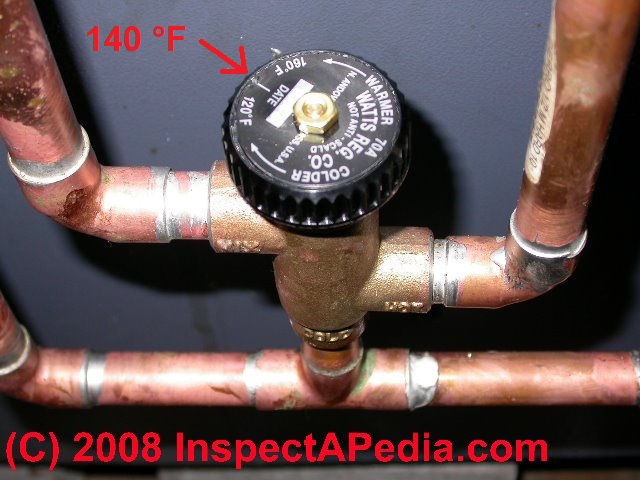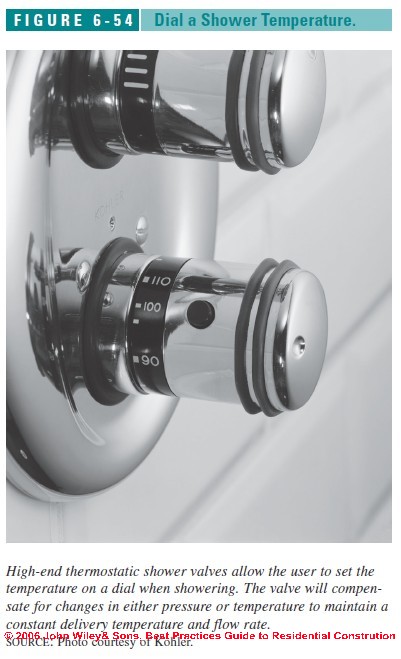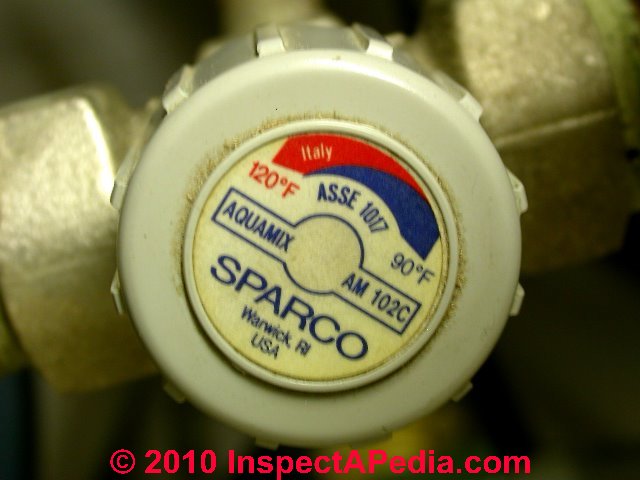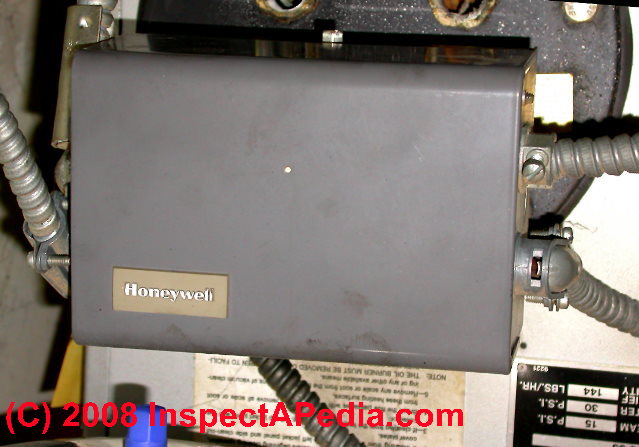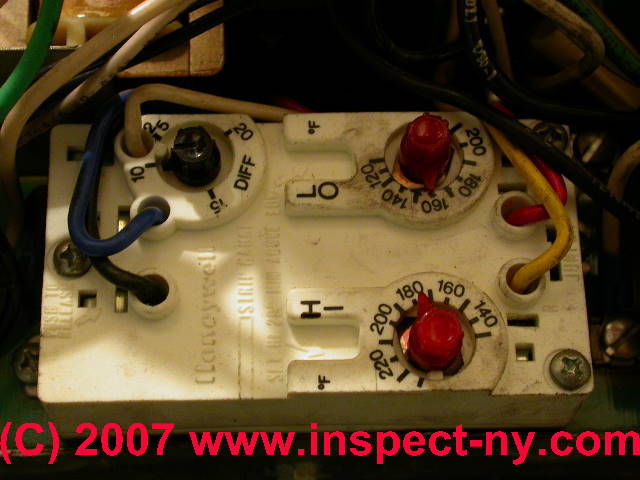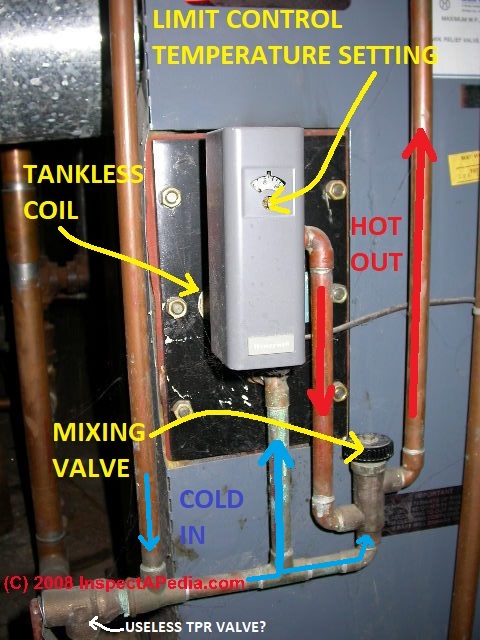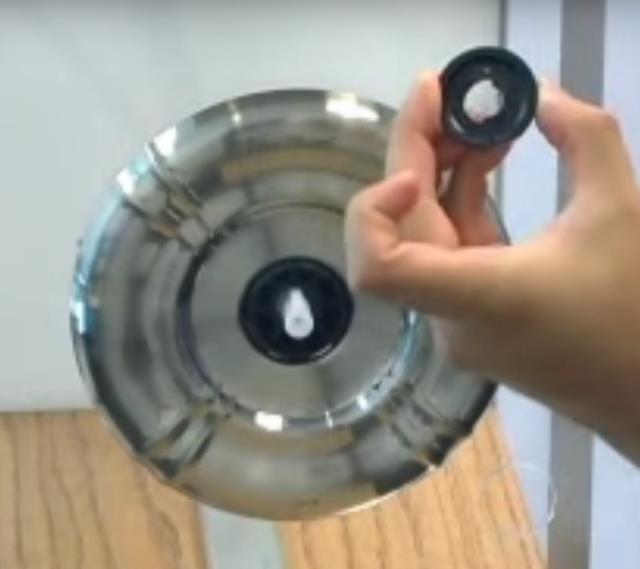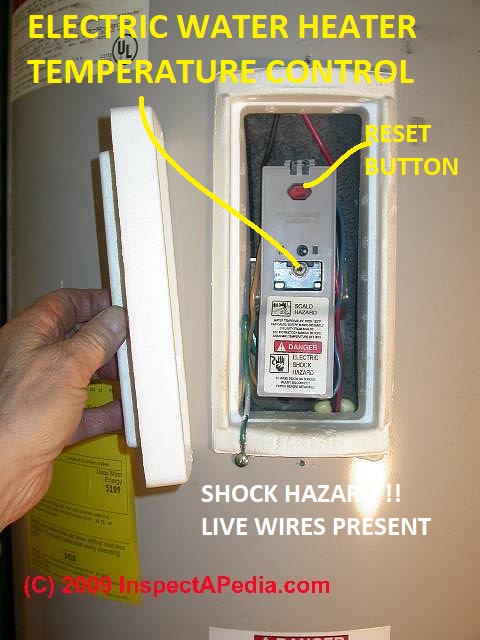 Hot Water Temperature Adjustment
Hot Water Temperature Adjustment
How to set, raise, or lower hot water heater temperature
- POST a QUESTION or COMMENT about this article topic.
This article describes the various controls used on different types of water heaters and explains how each control is used to set domestic hot water temperature.
Whether your hot water is produced by a tankless coil, indirect water heater, calorifier, geyser, electric, gas, or oil fired water heater or other water heating device, the heater will have a control that allows you to manage the heater's output temperature. We also point out the usefulness of anti-scald valves.
InspectAPedia tolerates no conflicts of interest. We have no relationship with advertisers, products, or services discussed at this website.
- Daniel Friedman, Publisher/Editor/Author - See WHO ARE WE?
How to adjust hot water temperature
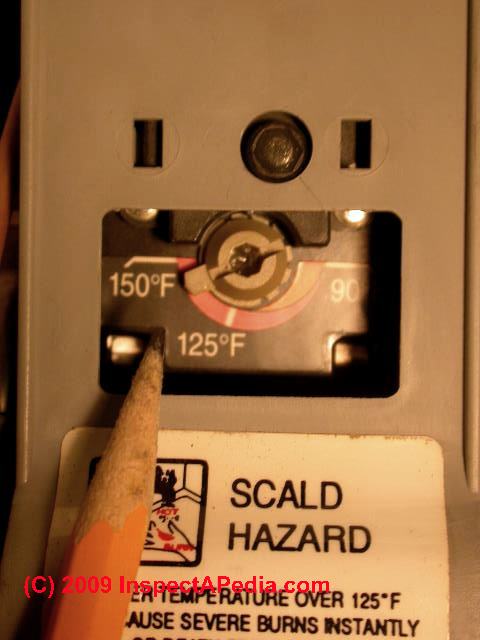 To adjust the temperature of your domestic hot water supply (for washing and bathing) up (hotter) or down (cooler) we need first to know how hot water is made in your building.
To adjust the temperature of your domestic hot water supply (for washing and bathing) up (hotter) or down (cooler) we need first to know how hot water is made in your building.
Here we list all of the types of controls that are used to set hot water temperature. We explain where they're found and how to adjust water temperature for each control.
If you don't see your water heater type in this list, post a question at the end of this page along with a photo of your water heater.
ArticleSeries Contents
- ANTI-SCALD WATER TEMPERATURE CONTROL TYPES
- ELECTRIC HOT WATER TEMPERATURE CONTROL
- ELECTRIC SHOWER HEATER TEMPERATURE CONTROL
- GAS HOT WATER TEMPERATURE CONTROL
- INDIRECT HOT WATER HEATER TEMPERATURE CONTROL
- MANUAL HOT WATER TEMPERATURE CONTROLS
- OIL HOT WATER HEATER TEMPERATURE CONTROL
- POINT OF USE HOT WATER TEMPERATURE CONTROLS
- RANGE BOILER HOT WATER TEMPERATURE CONTROL
- SIDE ARM COIL HOT WATER TEMPERATURE CONTROL
- SOLAR HOT WATER HEATER TEMPERATURE CONTROL
- TANKLESS COIL HOT WATER HEATER TEMPERATURE CONTROL
- TANKLESS HOT WATER HEATER TEMPERATURE CONTROL
Electric Water Heater Temperature Control
On an electric water heater or calorifier there will be one, or as in our photo, two electric heating elements with one or two adjustable temperature control thermostats.
Details are at ELECTRIC HOT WATER TEMPERATURE CONTROL
Electric Shower Heater Temperature Control
If your home uses an electric shower heater right in the shower itself it will look something like the device above.
[Click to enlarge any image]
When a sensor in the shower head detects water flowing, the electrical heating element turns on.
An electrical element heats water as it enters and flows through the unit, drawing typically about 23 amps (when wired at 110V 2400 watts) or 13.5 amps (when wired at 220V 2900 watts).
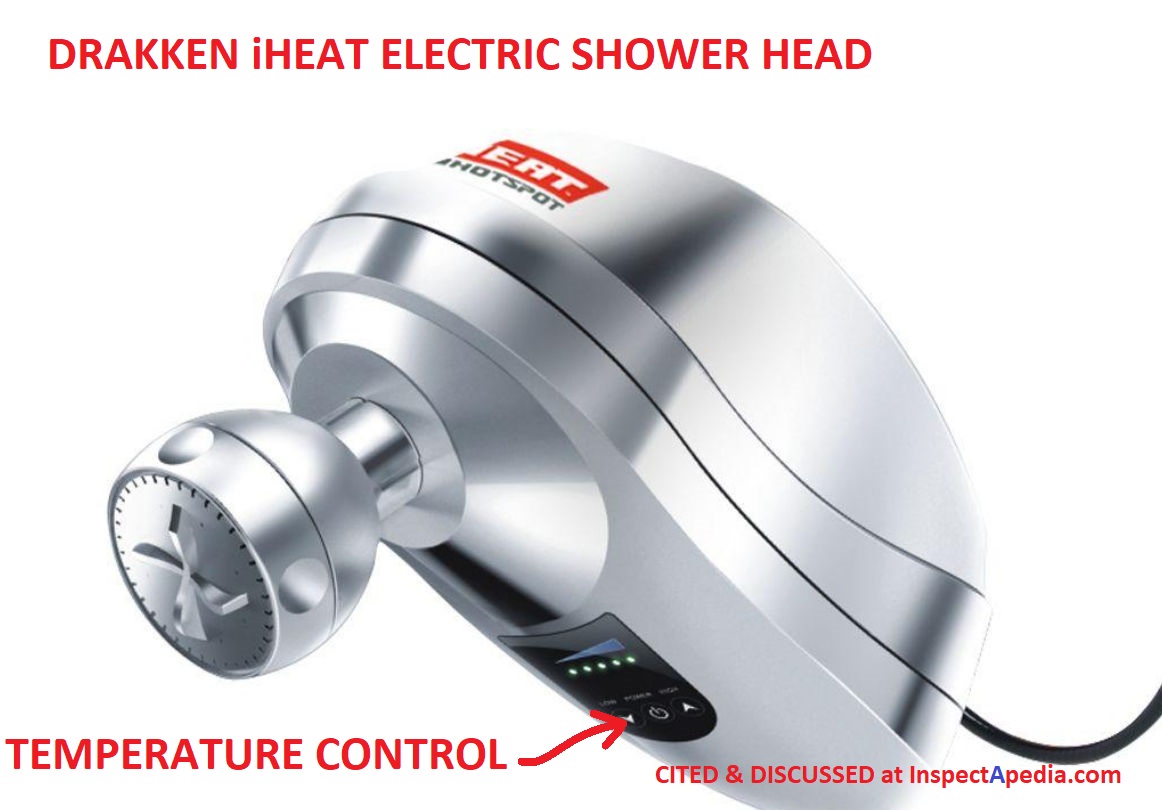 Some electric shower heaters permit a range of temperature control by buttons or switches on the shower head.
Some electric shower heaters permit a range of temperature control by buttons or switches on the shower head.
Shown here is the iHEAT electric point of use or "tankless" electric shower heater, from Drakken and cited below. Buttons on the control head permit some adjustment of the shower heater's output temperature.
On most and virtually all older electric shower heaters, you have no control over the temperature of hot water produced by an electric shower heater except by regulating the rate of water movement through the shower head.
Instead, the electric shower head output temperature is "controlled" by selecting a unit with heating capacity or wattage that is matched to the anticipated incoming water temperature at the shower head.
The Drakken iHeat electric shower head charts shown here were provided by Home Depot (2020/04/27).
Watch out: for any electric shower heater to be effective the model must be chosen matched to the anticipated input water temperature as well as the required flow rate.
See details at ELECTRIC SHOWER HEATERS for details about the iHeat and other electric shower heaters, also referred to as tankless electric water heaters.
Tankless Electric Shower Heater Selection Charts Provide Temperature "Control"
These four charts, provided by Home Depot stores and authored by Drakken for its iHEAT tankless electric shower head, illustrate the process of selecting a point of use, tankless, electric shower heater whose heating capacity is matched to the anticipated input water temperature, water flow rate, and other factors.
[Click to enlarge any image]
By paying attention to the manufacturer's recommendations the user has some degree of control over the output temperature of the electric shower heater.
Watch out: installing an electric shower heater that is too-powerful for the incoming water temperature (incoming water is warmer than planned) or for the flow rate (flow rate is slower than planned) risks scalding hazards.
Watch out: installing an electric shower heater that is not powerful enough for the incoming water temperature (incoming water is colder than planned) or for the flow rate (flow rate is faster than planned) is likely to mean that the shower temperature is too low or is inadequate.
Gas fired water heater Temperature Control
If your hot water is made by a gas-fired water heater like the one shown above, usually there is a water temperature setting control dial right at the gas valve on the water heater.
[Click to enlarge any image]
Arrows on the gas valve temperature control will point to HOT, WARM, or COOLER or on some valves "Vacation" which is a stand-by low temperature mode.
See details at
- WATER HEATER MANUALS - find the water heater temperature setting control instructions for your specific water heater brand and model
- GAS FIRED WATER HEATERS - home
- GAS WATER HEATER TEMPERATURE
- Honeywell GAS CONTROL on DIRECT ENT WATER HEATERS, CONTROL MANUAL [PDF] (2017) RESIDENTIAL POWER DIRECT VENT GAS -FIRED WATER HEATERS Owners Manual Supplement for water heaters equipped with FVIR Technology
- HONEYWELL CONTROLS
Indirect Water Heater Temperature Control
If your hot water is made in a separate hot water tank or cylinder that is in turn heated by a piping zone or loop from your home gas, oil or electric heating boiler.
The temperature control for the indirect water heater will be an aquastat, usually mounted right on the indirect water heater tank (where it can sense the hot water temperature in the hot water tank.
In our photo yellow text label identies the aquastat / limit control mounted right on the indirect water heater tank. This is the temperature controller.
On that limit control - a narrow vertical box with a gray cover - if you look closely
[Click to enlarge any image]
you'll see a numbered dial that indicates the temperature setting on the control.
Typically, as we show below, the limit control will be set to a "safe" 120 F.
Hot water temperature is adjusted up or down by changing th setting in that limit or aquastat control.
On an indirect-fired hot water tank the aquastat will may provide both a High temperature limit (a safety feature) and Low temperature limit, thus setting the range within which the heating system is going to be asked to keep the water hot.
How does this indirect water heater work?
In our sketch, adapated from Amtrol® the indirect-heated hot water tank is shown in blue.
[Click to enlarge any image]
This drawing is not to scale as we made the heating boiler - source of heat for the indirect hot water tank - tiny (red) so as to fit onto the page.
When hot water temperature in this indirect water heater tank falls to or below the low limit, the control will turn on a circulator to bring hot water from the building's heating boiler through a loop of pipes that sends water through a coil inside the indirect water heater tank.
That coil re-heats domestic hot water.
Domestic hot water is supplied to the building by a pair of separate pipes: incoming cold water from the building water supply piping and outgoing hot water to building hot water faucets or spigots at sinks, tubs, showers, etc.
See details at INDIRECT WATER HEATER TEMPERATURE CONTROLS
And see details at AQUASTAT FUNCTIONS - aquastats used as upper and lower limit controls on oil fired water heaters.
Oil Fired Water Heater Temperature Control
 If your hot water is made by an oil-fired free-standing water heater like the one shown here, the temperature is controlled by an aquastat - a device that senses the temperature of water in the heater.
If your hot water is made by an oil-fired free-standing water heater like the one shown here, the temperature is controlled by an aquastat - a device that senses the temperature of water in the heater.
At OIL FIRED WATER HEATERS we give details about how to identify an oil-fired hot water heater.
[Click to enlarge any image]
On an oil-fired water heater the temperature is controlled by an aquastat
- a device that senses water temperature inside the heater and that will turn the oil burner on or off according to settings on the aquastat.
In our photo the red arrow points to the aquastat control.
Most oil fired water heaters may have a simple aquastat such as that shown
at LIMIT SWITCHES, BOILERS combination aquastats or single-limit simple aquastats may be used as upper and lower limit controls on oil fired water heaters
Also see THERMOSTATS, WATER HEATER for a description of aquastats that may be used on oil fired water heaters.
Also see OIL FIRED WATER HEATERS
Above: The gray control box pointed to by our arrow will contain the heater's temperature control aquastat.
Watch out: this particular oil-fired hot water heater is unsafe: there is no extension on the relief valve
- someone could get scalded, and all of that soot around the combustion chamber inspection door tells us that the heater has been running with improper draft, combustion settings or other malfunction.
Range Boiler Hot Water System Temperature Control
Range boilers making domestic hot water work by circulating domestic hot water from the separate range boiler hot water tank through a heating coil that is either inside the building's heating boiler
or the range boiler may heat its water by a heating coil that is physically outside the heating boiler but is attached to it. This similar device is called a side-arm coil - illustrated below. .
Range boilers work to produce hot water in a similar fashion as do indirect fired water heaters - using a heat exchanging coil but with an important difference.
A range boiler heats its water by gravity rather than by using a circulator pump so you won't find a limit control.
Temperature control for a range boiler is provided by controlling temperature of the boiler itself. On a modern oil or gas fueled heating boiler those controls will be limit controls or aquastats.
Details are at
- AQUASTAT FUNCTIONS - aquastats used as upper and lower limit controls on oil fired water heaters.
- RANGE BOILERS - home
- TANKLESS COIL HOT WATER HEATER TEMPERATURE CONTROL
Side Arm Coil Hot Water Temperature Control
A side-arm coil may work like a conventional in-boiler tankless coil, OR it may be piped to heat a separate indirect tank of hot water similar to an indirect fired water heater or a range boiler.
Below is a sketch, courtesy of Carson Dunlop Associates, of a side arm heater coil - an ancestor of both a modern tankless coil and of the modern indirect-fired hot water tank.
Carson Dunlop Associates is a Toronto home inspection, education, and report writing tool company and a contributor to InspectApedia.com.
Hot water temperature at a side arm heater will be controlled by one or more of the following:
- ANTI SCALD VALVES & TEMPERATURE CONTROL / MIXING VALVES installed at the heater's hot water outlet or at individual plumbing fixtures
- AQUASTAT CONTROLS - home - an aquastat on the heating boiler
- MANUAL HOT WATER TEMPERATURE CONTROLS
Solar Hot Water System Temperature Controls
Here we illustrate the three most-common methods of controlling or adjusting hot water supply temperature from a solar water heating system.
1. A control aquastat at the solar hot water tank
Most solar water heating systems include an aquastat at the water storage tank that controls the circulation of water through the solar collector.
Shown here: Honeywell L4006-series high-limit aquastat.
[Click to enlarge any image]
At the hot water tank you'll find an aquastat similar to the one shown.
To adjust this hot water temperature ontrol a setscrew is turned to move the high limit dial of the aquastat up or down.
On some single limit aquastat controls the dial is hidden inside the control: you'll have to remove the cover.
Instead of a setscrew, a thumb-wheel or notched dial may be present. That type of limit control is set simply by rotating the dial with your thumb to set the temperature higher or lower.
Find manuals for this and other aquastats
at BOILERS - HOT WATER HEAT CONTROLS used on heating boilers & some water heaters
2. Mixing Valve for Hot Water Temperature Control at the Solar Hot Water Tank Outlet
If water stored in the storage tank may be set above 140 °F a mixing valve is also used to temper the outgoing hot water with cold.
If your hot water is made by a solar water heater then the water temperature is controlled by both devices: a mixing valve (not always present) and an aquastat that controls boiler temperature then there are two temperature adjustments on the solar system..
Our photo shows a mixing valve or tempering valve, also called an anti-scald valve.
Arrows on the valve indicate which way to turn it to make outgoing water warmer (counterclockwise) or cooler (clockwise).
Watch out: however if you set the mixing valve or anti-scald device to deliver hot water at the plumbing fixtures (showers, sinks, tubs) at temperatures above 120F there is a risk of scalding burns.
see details at ANTI SCALD VALVE at TANKLESS COIL
3. Solar hot water temperature controlled by point of use anti-scald valves.
Local or point of use or add-on anti-scald hot water temperature controls are often used with solar hot water systems.
Controls with a built-in anti-scald feature that is thermosatically controlled, either right in the control like the controls shown above, or as a separate add-on anti-scald control nearby, like the Sparco® anti-scald control shown just below in our second illustration.
Details of controls used for solar hot water temperature are at
- SOLAR HOT WATER HEATERS
- POINT of USE BUILT-IN FIXTURE ANTI-SCALD VALVES
- Steibel SOLAR HOT WATER COLLECTOR INSTALLATION MANUAL [PDF] solar hot water heating systems, https://www.stiebel-eltron-usa.com/products/solar-thermal-hot-water-systems-individual-components retrieved 2020/04/27, original source: https://www.stiebel-eltron-usa.com/sites/default/files/pdf/install-sol27.pdf
Excerpt: Warning: setting the maximum tank temperature higher than 140 °F at the control unit is permissable only with a thermostatically-conrolled DHW mixing valve. Otherwise there can be a risk of scalding at the drawoff point.
Tankless Coil Hot Water SystemTemperature Controls
If your hot water is made by a tankless coil attached to or more-often part of your home heating boiler then the water temperature is controlled by one or possibly two devices: a mixing valve (not always present) and an aquastat that controls boiler temperature.
[Click to enlarge any image]
1. Mixing Valve for Hot Water Temperature Control on a Heating Boiler with Tankless Coil
If there is a mixing valve or anti scald device at your tankless coil, this is an easy place to make your hot water hotter or cooler.
Our photo shows a mixing valve near the tankless coil on a hydronic (hot water heating system) boiler. Arrows on the valve indicate which way to turn it to make outgoing water warmer (counterclockwise) or cooler (clockwise).
Watch out: however if you set the mixing valve or anti-scald device to deliver hot water at the plumbing fixtures (showers, sinks, tubs) at temperatures above 120F there is a risk of scalding burns.
see details at
Similar controls of hot water temperature are used for
- RANGE BOILER WATER HEATER an older form of indirect-fired hot water heating used with separate heating boilers
- SIDE ARM COIL WATER HEATER similar to instantaneous and tankless coil water heaters, often used with range boilers
2. Aquastat for Hot Water Temperature Control on a Heating Boiler with Tankless Coil
Completely separate from and independent of the mixing valve or anti-scald valve, aquastat control on the heating boiler (shown below) sets the temperature inside the heating boiler.
It is that hot boiler water that in turn heats the tankless coil that in turn heats domestic hot water flowing through the coil.
Most hydronic heating systems use a control aquastat that will have a HI, LO, and DIFF setting that affects domestic hot water temperature provided by the tankless coil.
The HI LO and DIFF controls to control hot water temperature (and boiler temperatures). If you don't care how they work or what they do, but you just want to set them correctly, then
see AQUASTAT HI LO DIFF SETTINGS - how to set the HI LO and DIFF on a boiler aquastat.
Some hot water heating systems and even some steam boilers that are also used to heat a tankless coil, as well as some oil fired water heaters use a simpler single-limit or dual-limit aquastat like the one shown below.
Above: a single limit control installed on the tankless coil of a steam boiler used to heat a tankless coil for domestic hot water supply.
You'll notice that this boiler sports both a single limit aquastat (controlling domestic hot water temperature) and also a mixing valve that provides more temperature control and scald protection.
The single limit aquastat or control is explained in detail at LIMIT CONTROL, SINGLE .
[Click to enlarge any image]
You'll see that it has usually one adjustable temperature setting that is turned using a screwdriver.
Like the more complex HI-LO-DIFF aquastats shown earlier, you may have to remove the cover of some of these limit controls to access the temperature setting device(s).
Watch out: there are quite a few different models and types of heating boiler and oil or gas fired water heater aquastats. To sort out which aquastat your heater has
see complete details at AQUASTAT CONTROLS -
The operating manuals for each of these can be found
at MANUALS for HEATING & A/C SYSTEM CONTROLS aquastat installation & repair guide
Above, a typical Honeywell limit control on a hot water system, set to a safe 120 °F.
Common causes of an un-wanted drop in hot water temperature
if your hot water temperature seems to have dropped there are a several things to check:
- Hot water temperature control:
Is there a temperature regulating device such as an anti-scald valve at your heating boiler that has been changed or has become mineral-clogged it might not be regulating the outgoing hot water to the same temperature level.
You may need to adjust or replace the anti-scald valve.
Details are above on this page and
At ANTI SCALD VALVES & TEMPERATURE CONTROL / MIXING VALVES - Colder incoming water:
Is the lower hot water temperature something you observe in very cold weather?
It's possible that the incoming water supply is much colder, so the outgoing hot will be less hot.
A water heater of any sort can raise the water temperature above the incoming water to the tank, but that temperature increase is limited, so when incoming water is quite cold, outgoing hot may be less hot.
If your water heater uses an anti-scald valve that device should be maintaining the temperature of outgoing hot water regardless of the temperature of incoming cold to the water heater, so that temperature control may need replacement. - Tankless coil clogging:
Have you tested your water for hardness (mineral content)?
If your hot water is made by a tankless coil in the heating boiler and if minerals are clogging the coil, not only may the hot water flow rate ("hot water pressure") be reduced, but heat transfer from the heating boiler into water passing through the heating coil can be reduced too, reducing the tankless coil output temperature.
Details are at CLOGGED TANKLESS COIL or PIPES, LIME SCALE - More help is at HOT WATER IMPROVEMENTS
Tankless Water Heater Temperature Control
If your hot water is provided by a demand-type system that does not include an actual hot water tank or cylinder, such as demand or tankless water heaters like the little Rheem electric tankless water shown here, the temperature control will be on a dial or push-buttons on the heater's control panel.
[Click to enlarge any image]
See details at TANKLESS WATER HEATERS
Or for the little water heater shown just above
see RHEEM TANKLESS WATER HEATER LEAK REPAIR
Timers as Building Hot Water Temperature Controls
In addition to or instead-of an automatic, thermostatically-controlled anti-scald device that may be installed right at your water heater (such as the tankless coil system listed above), your building hot water temperature may be controlled by either a manual mixing valve at the heating boiler or tankless coil or elsewhere in the system.
Or hot water temperatures may be controlled by special "point of use" controls built right into or installed next to water controls or faucets at tubs, showers or sinks.
Some electric water heaters are installed with a timer (photograph above) that saves electricity costs by turning off the heater during periods when no one will be using hot water.
Manual Hot Water Temperature Control Valves
The manual mixing valve is opened to allow some cold water to mix in with the outgoing hot water from the hot water source - in our photo that's a tankless coil.
An advantage of this method of controlling hot water temperature is that it is simple. But hold on:
Watch out: The disadvantage of this hot water temperature control method is that the boiler's internal temperature, and thus the temperature of hot water leaving the tankless coil, will be different in winter when there is a call for heat keeping the boiler hot than in summer when there is no call for heat and the boiler operates at a lower temperature.
So a domestic hot water supply temperature that is safe in summer may be too cool in winter
while the same system may produce hot water that is dangerously scalding in winter - if you forget to adjust the manual tempering valve.
[Click to enlarge any image]
See details
at MANUAL ANTI-SCALD TEMPERING VALVES installed at a tankless coil or elsehwhere on the plumbing system, mixing cold in with hot water.
Automatic or thermostatically controlled anti-scald valves are discussed
at TANKLESS COIL HOT WATER HEATER TEMPERATURE CONTROL
Point of Use Hot Water Temperature Controls
There are several classes of "point of use water heater" temperature controls:
- Point of use temperature controls at individual faucets and fixtures - discussed here and in complete detail
at TYPES of WATER TEMPERATURE CONTROLS - mechanical stop or temperature limit, thermostatic control, pressure regulation, pressure compensation, manual mixing valves- MECHANICAL STOP TEMPERATURE LIMIT at a POINT OF USE FIXTURE
- PRESSURE COMPENSATING CONTROL at POINT OF USE
- Point of use temperature controls on an electric point-of-use water heater - discussed
at ELECTRIC HOT WATER TEMPERATURE CONTROL
Also see ELECTRIC POINT OF USE WATER HEATERS
- Electric shower heaters - discussed
at ELECTRIC SHOWER HEATER TEMPERATURE CONTROL
There may be one or more "point of use" anti-scald devices such as are often found installed in hotels - like the valve shown above, installed in a bath in Molde, Norway.
Point of use hot water temperature controls such as may be found at tubs, showers, and some sinks, are adjusted either
- By an external and visible adjustable dial or setting right on the control
or
- By an internal adjustment, turning a control nut or positioning a control bushing or washer inside the control. This method requires dis-assembly of the water control valve.
An example of how a point of use hot water temperature control like the Pfister unit shown below is adjusted is
at POINT of USE ANTI-SCALD WATER TEMPERATURE ADJUST Pfister
See more details
at POINT of USE BUILT-IN FIXTURE ANTI-SCALD VALVES
and
at BUILT-IN FIXTURE ANTI-SCALD VALVES
...
...
Continue reading at WATER HEATER TEMPERATURE TOO COLD or TOO HOT, or select a topic from the closely-related articles below, or see the complete ARTICLE INDEX.
Or see these
Recommended Articles
- ANTI SCALD VALVES & TEMPERATURE CONTROL / MIXING VALVES - home
- ANTI-SCALD WATER TEMPERATURE CONTROL TYPES
- WATER HEATER TEMPERATURE ADJUSTMENT CONTROLS - home
- AQUASTAT CONTROL FUNCTIONS
- ELECTRIC HOT WATER TEMPERATURE CONTROL
- ELECTRIC SHOWER HEATER TEMPERATURE CONTROL
- ELECTRIC WATER HEATER HIGH TEMP CUTOFF
- ELECTRIC WATER HEATER THERMOSTATS
- GAS HOT WATER TEMPERATURE CONTROL
- GAS WATER HEATER TEMPERATURE
- INDIRECT HOT WATER HEATER TEMPERATURE CONTROL
- LIMIT SWITCH, SINGLE FUNCTION AQUASTATS Oil Heater
- MANUAL HOT WATER TEMPERATURE CONTROLS
- OIL HOT WATER HEATER TEMPERATURE CONTROL
- POINT OF USE HOT WATER TEMPERATURE CONTROLS
- SCALDING TEMPERATURES & TIMES
- SOLAR HOT WATER HEATER TEMPERATURE CONTROL
- TANKLESS COIL HOT WATER HEATER TEMPERATURE CONTROL
- TANKLESS HOT WATER HEATER TEMPERATURE CONTROL
- THERMOSTATS, WATER HEATER for oil fired water heaters or water cylinders
- WATER HEATER TEMPERATURE TOO COLD or TOO HOT
Suggested citation for this web page
WATER HEATER TEMPERATURE ADJUSTMENT CONTROLS - home at InspectApedia.com - online encyclopedia of building & environmental inspection, testing, diagnosis, repair, & problem prevention advice.
Or see this
INDEX to RELATED ARTICLES: ARTICLE INDEX to WATER HEATERS
Or use the SEARCH BOX found below to Ask a Question or Search InspectApedia
Ask a Question or Search InspectApedia
Try the search box just below, or if you prefer, post a question or comment in the Comments box below and we will respond promptly.
Search the InspectApedia website
Note: appearance of your Comment below may be delayed: if your comment contains an image, photograph, web link, or text that looks to the software as if it might be a web link, your posting will appear after it has been approved by a moderator. Apologies for the delay.
Only one image can be added per comment but you can post as many comments, and therefore images, as you like.
You will not receive a notification when a response to your question has been posted.
Please bookmark this page to make it easy for you to check back for our response.
IF above you see "Comment Form is loading comments..." then COMMENT BOX - countable.ca / bawkbox.com IS NOT WORKING.
In any case you are welcome to send an email directly to us at InspectApedia.com at editor@inspectApedia.com
We'll reply to you directly. Please help us help you by noting, in your email, the URL of the InspectApedia page where you wanted to comment.
Citations & References
In addition to any citations in the article above, a full list is available on request.
- Our recommended books about building & mechanical systems design, inspection, problem diagnosis, and repair, and about indoor environment and IAQ testing, diagnosis, and cleanup are at the InspectAPedia Bookstore. Also see our Book Reviews - InspectAPedia.
- In addition to citations & references found in this article, see the research citations given at the end of the related articles found at our suggested
CONTINUE READING or RECOMMENDED ARTICLES.
- Carson, Dunlop & Associates Ltd., 120 Carlton Street Suite 407, Toronto ON M5A 4K2. Tel: (416) 964-9415 1-800-268-7070 Email: info@carsondunlop.com. Alan Carson is a past president of ASHI, the American Society of Home Inspectors.
Thanks to Alan Carson and Bob Dunlop, for permission for InspectAPedia to use text excerpts from The HOME REFERENCE BOOK - the Encyclopedia of Homes and to use illustrations from The ILLUSTRATED HOME .
Carson Dunlop Associates provides extensive home inspection education and report writing material. In gratitude we provide links to tsome Carson Dunlop Associates products and services.


